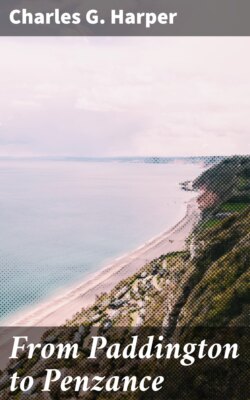Читать книгу From Paddington to Penzance - Charles G. Harper - Страница 6
IV.
ОглавлениеChertsey we passed this morning, heated with rowing, but between this and Laleham we were so far fortunate as to fall in with some acquaintances on a steam-launch who took us in tow so far as Old Windsor Lock, where we cast off and proceeded alone, landing at one of the many slips by Eton Bridge.
Windsor and Eton claimed us for the remainder of the day for the due pursuance of some desultory sight-seeing, but Eton chiefly, for the sake of its College, where “her Henry,” that unhappy pious founder, Henry VI., stands in effigy in the great quadrangle, and casts a “holy shade,” according to Grey.
“HER HENRY”
The “College of the Blessed Mary of Eton beside Windsor” has numbered among its scholars a goodly proportion of our famous men; and many of their names, carved on the woodwork of the schools in their schoolboy days, remain to this day. On the doorway leading from the Upper School into that place of dread, the headmaster’s room, may be seen carved, in company with other well-known names, that of “W. E. Gladstone;” and once within that apartment, your attention is drawn to the block whereon many have suffered, in less heroic wise, and by no means so tragically, as the martyrs of Tower Hill, but perhaps more painfully, for birch twigs, with the buds on them, must sting dreadfully. But these things are become historical relics rather than engines of contemporary punishment: they belong to the days of the terrific Keate and his robustious predecessors, who were wont to regard the fortiter in re as more convincing and a better preservative of discipline than the suaviter in modo.
W. E. GLADSTONE
It seems that everywhere the iron gauntlet gives way to the kid glove in our times; persuasion is to-day more a mental than a physical process. There are relics in plenty at Windsor and Eton of those times, only at Windsor these things take higher ground: there for persuasion read diplomacy in this era, where it had used to be a performance requiring the assistance of axe and chaplain. The Castle survives, its mediæval defences restored, for appearance sake, but its State apartments filled with polite furniture, dreadfully gilded and (we thought) tawdry. It makes a picture, this historic warren of kings and princes, and its Round Tower commands a glorious view, altogether an imposing range of turrets, battlements, and loopholed walls; but, alas! Henry the Eighth’s massive gateway was guarded by a constable of that singularly unromantic body—the Police, and his presence there made everything save the gas-lamps and the shop-fronts of Windsor streets seem of paste-board fashion and unreal.
STAIRCASE IN ETON COLLEGE.
The river is the proper place from whence to view the Castle: the time, early morning; for then, when the mists cling about the water, and the meadows are damp with them, that palace and stronghold, that court and tomb of royalty bulks larger than at any other time, both on sight and mind.
WINDSOR: EARLY MORNING.
Thus we thought, when the early hours of the morning found us afloat again. Boveney, Monkey Island, were passed, and now arose above all the trees, the tall poplars that identify Bray to the distant view more surely than church or anything contrived at the hands of man. They range in rows, and are at once formal and touched with a delightful note of distinction. The village, too, is of the quaintest, with almshouses that should make the poverty housed within them dignified with a dignity that we who live in London’s hutches of brick and mortar, and are numbered with a plebeian number, may never know.
And at this Bray (we are told) lived that weathercock vicar, who twirled with every political wind, and by his dexterity kept his benefice and earned immortality. O most sensible Vicar of Bray: wholly admirable and right reverend exponent of expediency!
When once the bend of the river just above Bray is reached there is an end, for the time, of beauty, for the reach runs straight, and on either bank the encroachments of villadom are forming a continuous frontage of houses on to Taplow and Maidenhead, and three parts of the way to Cookham. Taplow Railway Bridge, brick-built, with bricks of a jaundiced hue, straddles over the water in two strides, an unlovely bridge, but remarkable for the great span of its arches, and for their extreme depression. So flat are the two arches of Taplow Bridge, that it seems scarcely credible they can bear the weight of the heavy trains constantly crossing. Yet fifty years have passed, and still the constant traffic of the Great Western Railway passes unharmed.
CLIEVEDEN.
Beyond Taplow comes Maidenhead, most favoured of riverside towns, and, at the far end of Maidenhead, Boulter’s Lock, the busiest on the river, filled from morn to eve of summer days with boats full of the smartest frocks and prettiest girls one would wish to see. No more charming sight than Boulter’s on a busy day, when the boats are going up stream to Clieveden and Cookham. Clieveden woods on the right hand, and Ray Mead level on the left, with the river between, green with the reflections of the trees, and splashed here and there with the bright-coloured blazers of the rowers, make a sight to be remembered.
We came late round the bend to Cookham Lock, and into Cookham village from the landing-place, as the moon rose in a cloudless sky.
